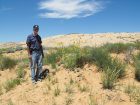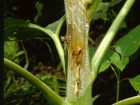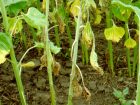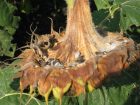
Features
Agronomy
Other Crops
Tapping into the wild side
Those humble wild sunflowers you see growing along prairie roadsides are key weapons in the fight against sclerotinia in sunflower crops. Through a long, complex process, researchers are transferring resistance genes from wild species into cultivated sunflower and gradually upping the crop’s ability to fight off this pathogen.
May 10, 2018 By Carolyn King
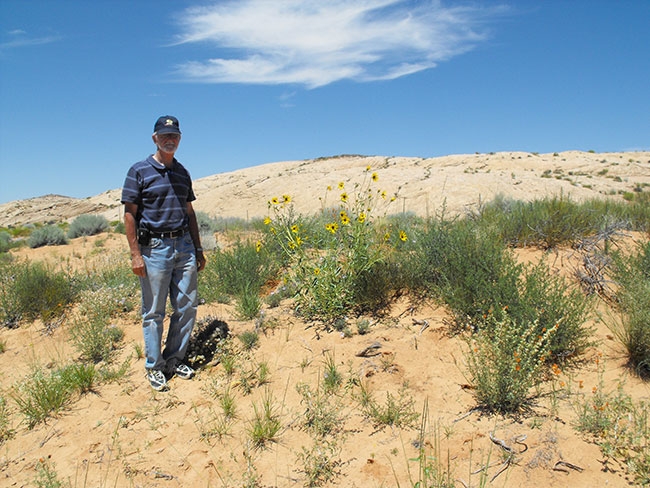 Part of Seiler’s work involves collecting germplasm from wild sunflower species. Those humble wild sunflowers you see growing along prairie roadsides are key weapons in the fight against sclerotinia in sunflower crops.
Part of Seiler’s work involves collecting germplasm from wild sunflower species. Those humble wild sunflowers you see growing along prairie roadsides are key weapons in the fight against sclerotinia in sunflower crops.“Sclerotinia sclerotiorum is a very obnoxious fungus. It causes disease in over 400 species of plants including some of our major field crops like canola, sunflower, soybeans, peas and beans, and some vegetable crops,” says Khalid Rashid, a plant pathologist with Agriculture and Agri-Food Canada (AAFC) in Morden, Man.
He explains this pathogen causes three different diseases in sunflower: basal stalk rot, mid-stalk rot and head rot. Basal stalk rot, also called sclerotinia wilt, is a soilborne disease. “The fungus overwinters as hard, black masses of mycelia called sclerotia, which are roughly the size of sunflower seeds. In the spring, if soil moisture conditions are normal in the sunflower field, sclerotia in the soil will germinate by forming mycelia. The mycelia infect the roots and cause rot of the root or the basal part of the stem.” Symptoms can include a tan canker at the base of the stem, white mould around the canker, and wilting and death of the plant.
In mid-stalk rot and head rot, infection is initiated by wind-borne spores originating in the sunflower field or a nearby field. “If the soil is saturated with water and the sclerotia are close to the soil surface, they produce mushroom bodies called apothecia, which look like inverted cups. The apothecia release ascospores into the air. In mid-stalk rot, the spores land on the stem, with the infection sometimes starting at a leaf axil. The infected stem becomes bleached and shredded, and the white fungus and black sclerotia form on the stem,” Rashid notes.
“If the ascospores land on the sunflower head at flowering or after, they cause head rot.” Early head rot symptoms can include spots on the back of the head or white mould on the seeds. As the disease develops, the whole head may eventually rot. Sclerotia form on the head and may be harvested with the seed or fall to the ground.
“Over the years, we have seen quite an increase in the incidence and severity of sclerotinia in sunflower and other susceptible crops in the Prairie provinces. Because of short rotations between host crops, there is now a lot of inoculum in the soil – we have about 20 million acres of canola, about three million acres of soybeans, and so forth,” he says. “From year to year, the incidence and severity of head rot and mid-stalk rot vary. In dry conditions, infection levels will be low. In humid, cloudy, drizzly or rainy conditions, you get more chances of infection.”
Why go wild?
Practices like crop rotation with cereals and fungicide application help in managing sclerotinia in sunflower. Several fungicides for sclerotinia suppression in sunflower are now registered in Canada.
However, highly resistant hybrids would be an invaluable tool for controlling sclerotinia in sunflower, so researchers are working towards that goal. “Because we could not find any meaningful genetic resistance to sclerotinia in cultivated hybrids or inbred lines, we have resorted to looking at the wild relatives of sunflower,” Rashid explains.
Those wild relatives are found in North America. “Sunflower is one of the few crops native to North America. The Native Americans were cultivating sunflower and did the early selection. Then in the 1500s, the Spanish introduced sunflower into Europe. The crop was further developed in Spain and then Russia. Then it was reintroduced into North America with the immigration particularly of Mennonites who settled in Canada,” explains Gerald Seiler, a research botanist with the U.S. Department of Agriculture’s Agricultural Research Service (USDA-ARS) in Fargo, N.D.
“[Through this long history of selection and breeding,] we’ve gone from a branched plant with multiple heads to a plant with a single head. And the plant has gone from just surviving and producing seed for the next generation, to a crop that has been selected for very high yield under optimum conditions. So the theory is that the wild relatives have traits that were lost in cultivated sunflower through this process.”
The presence of wild relatives has both positives and negatives for North American sunflower crops. “We have every disease and insect pest you can imagine because a lot of the wild species are alternate hosts,” Seiler says. “However, the wild relatives are still surviving so the thought is they might have some genetic components that defend against these pests.”
And that thought has proven to be true. “The first downy mildew resistance, the first verticillium resistance, the first rust resistance came from wild sunflowers back in the 1970s,” Seiler notes.
A long, complicated process
Using traits from wild relatives is an important part of the USDA-ARS sunflower breeding program. “Getting genetic diversity into a crop is a long-term, high-risk research endeavour, and that is why most companies in the sunflower business aren’t in this type of work,” Seiler explains. “At USDA-ARS, we undertake long-term, high-risk research.”
According to Rashid, the Canadian sunflower breeding program in Morden ended in 1995, but AAFC collaborates with sunflower breeding efforts at USDA-ARS and North Dakota State University. Rashid has worked with them on various studies.
At USDA-ARS, Seiler works on collecting wild sunflower germplasm, screening the material for various traits, and pre-breeding to move the traits into cultivated sunflower material.
The sunflower germplasm samples are stored at the USDA-ARS National Plant Germplasm System, North Central Regional Plant Introduction Station gene bank in Ames, Iowa, which is a co-operative effort between USDA-ARS, Iowa State University, and State Agricultural Experiment Stations. It is the world’s most diverse gene bank collection of sunflower germplasm. The collection includes cultivated sunflower, Helianthus annuus, and its 14 annual and 39 perennial wild relatives. Seiler says, “We have about 2,500 accessions of the wild relatives and about an equal number for cultivated sunflower, including cultivars from all over the world. The gene bank also distributes the material to researchers around the world.”
The breeding program screens the wild material in the greenhouse or field. Disease screening may involve either natural infection or inoculation, depending on the situation.
“Pre-breeding refers to crossing the wilds with the cultivated and trying to get something that looks like a cultivated sunflower but has the genetics of the crop wild relatives,” Seiler explains. “Then the industry can take the material at an early generation and incorporate the trait into their lines.”
Although the program has developed advanced techniques over the past 40 years, pre-breeding is still a complicated process that takes many years. “Three-fourths of our crop wild relatives are perennial, but we are trying to produce an annual crop. Generally we can get around the perennial nature by backcrossing, which means crossing it twice to the cultivated side,” Seiler says. “There are also differences in the size of the genetic content and differences in chromosome numbers, which can cause problems with fertility. As well, the crop and the wild relatives have different breeding systems and strategies. For example, an annual wild relative has to produce seed to continue the next generation so it produces a lot of heads with a lot of seeds and builds up a seed bank, but the seed sheds very easily. For cultivated sunflower, you don’t want traits like multiple heads and seed shedding, so they have to be bred out.”
Sclerotinia challenges and progress
In the early 2000s, Rashid and Seiler collaborated on collecting wild sunflowers in Canada. “We collected around 400 samples of wild sunflower from southern Manitoba,” Rashid says. “We collected samples of two species, Helianthus maximiliani and Helianthus nuttallii. We studied those accessions for their reactions to sclerotinia, rust, downy mildew, powdery mildew, and other diseases to see if we could find some good sources of genetic resistance.” Rashid has provided seed from those wild samples to AAFC’s gene bank in Saskatoon and to Doug Cattani at the University of Manitoba, whose research focuses on perennial breeding of grains and oilseeds. So even though Rashid is retiring this year, those accessions are available to other researchers.
“Some of the best material we have for sclerotinia resistance came from the Morden area, and some of the releases [of sclerotinia-resistant germplasms developed by USDA-ARS] were from those original populations collected there,” Seiler says. “One of our priority areas for sunflower collection in the future is to go back to Canada.”
Transferring sclerotinia resistance to cultivated lines presents some special complications. One complication is that each of the three sclerotinia diseases in sunflower requires its own selection and breeding work. USDA-ARS’s current efforts target head rot and basal stalk rot.
The other complication is that sclerotinia resistance involves multiple genes. “In diseases like sunflower rust or sunflower downy mildew, we have major genes that control resistance to specific races of the pathogen [and transferring a single resistance gene to cultivated sunflower is relatively straightforward]. But resistance to sclerotinia is quantitative,” Rashid explains.
In quantitative resistance, many genes are involved, with each gene having a small effect. “Every time a cross is made with the cultivated material there is the possibility that some of those sclerotinia resistance genes from the wild source can be lost,” Seiler notes. “So we have been able to develop germplasm or lines that have higher resistance to sclerotinia but not immunity.” However, each time they are able to find and add a new gene, it can add to the resistance already in the cultivated line.
“And that is what we have done with sclerotinia resistance. Finally, after almost 12 years, we have gone from some of our lines being 40 per cent infected to some lines being about two to five per cent to about 15 per cent infected,” he says. These latest lines have not yet been incorporated into commercial hybrids because they have just been released.
The USDA releases its sunflower germplasms for use by the seed industry and public researchers in creating parental lines or germplasms. The seed industry is making progress on sclerotinia resistance; for instance, some U.S. commercial hybrids are rated as resistant for head rot and/or basal stalk rot (on a scale ranging from highly resistant to susceptible).
“In Canada, most of the seed for our sunflower hybrids comes from the U.S. The seed companies may do their own testing of their lines in Canada or have testing done by private seed testing companies or the National Sunflower Association of Canada [NSAC],” Rashid explains.
The NSAC runs annual trials in co-ordination with Manitoba Agriculture, to provide third-party performance data for sunflower growers. These trials include both registered and experimental hybrids, and take place at several locations in the province.
Each year, Daryl Rex, the NSAC’s research agronomist, puts out a call for entries for these trials. He is hopeful that some hybrids with good sclerotinia resistance might be included in the 2018 trials. He notes that some of the hybrids with the best resistance are later maturing ones developed for U.S. conditions so maturity may be an issue. But, he says, “I think even if they are slightly later maturing hybrids, it would be interesting to see what the sclerotinia tolerance would be like under Manitoba conditions.”
“Over many years, we have been able ‘fish out’ these resistance genes from the large pool of genetic resources and utilize those genes to keep sunflower as a viable crop,” Seiler says.
In the years ahead, this process could become more efficient as advances enable the researchers to check a plant’s DNA for the desired traits rather than having to grow the seed into plants and test the plants for the traits. “We have a really good gene bank,” Seiler says. “We just have to be able to go in and pinpoint the genes. If we can save a few years in that process, then that will make everything better for everybody.”
